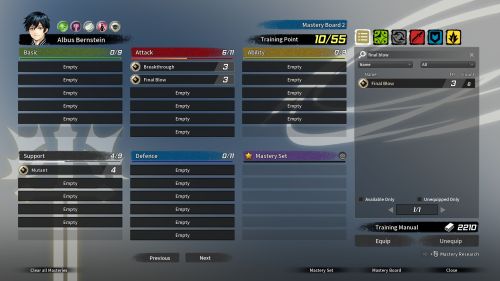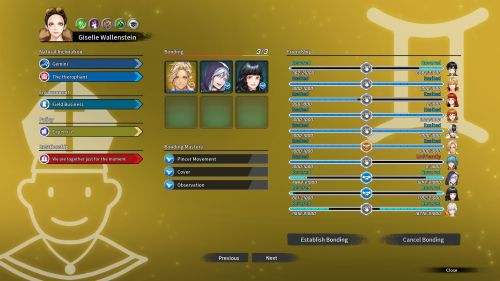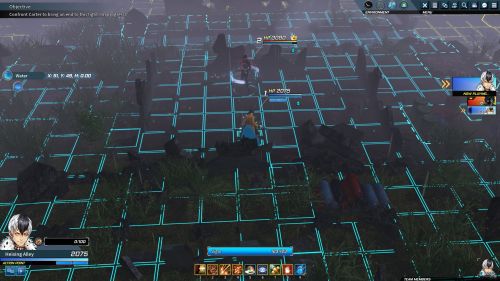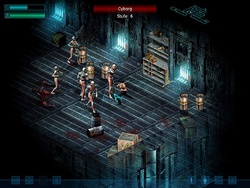RPG Codex Review: Troubleshooter: Abandoned Children is like the best goddamned game ever made
RPG Codex Review: Troubleshooter: Abandoned Children is like the best goddamned game ever made
Codex Review - posted by Infinitron on Tue 3 September 2024, 00:03:56
Tags: Dandylion; Troubleshooter: Abandoned Children[Review by Grunker]
I fucking hate anime. I hate the exaggerated art style, I hate the androgynous, omega-cucked protagonists, I hate the hyper-fixation on (and sexualization of) child characters who participate in the drama on the same level as the adults, I hate the nonsensical storytelling and I hate the juvenile combination of cartoon silliness and world-shattering melodrama that always seems to haunt every bit of writing in the genre.
So when I tell you that I have put a categorically shameful number of hours into my two playthroughs of Troubleshooter: Abandoned Children, despite the fact that it ranks among the worst offenders in the history of anime in most of the areas above (the art is… well, it’s fine for the genre), I want you to understand what this means about how insanely addictive the gameplay can be. I am putting up with what is perhaps the most incoherent, crackbrained, idiotic, loose-threaded story told in video game history and with writing so terrible and poorly translated it will make your 5-year-old cousin Billy's "and then..."-stories seem like poetic masterpieces, because this game is just that fucking great at tickling my brain in all its funny spots.
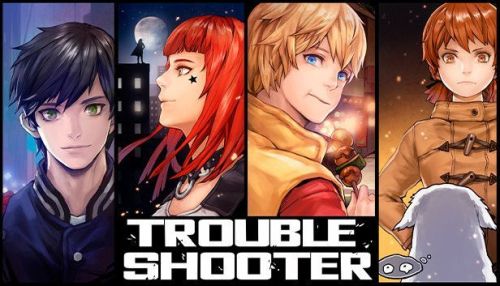
Yes, of course the girl on the right is a party member and yes of course she's friends with a chainsaw-wielding, pink-haired master assassin of the same age...
Fair warning, though: while Troubleshooter is so bloody amazing it has obtained a license to drive some of the most terrible anime tropes directly into my eyeballs on a daily basis despite my utter disdain for it, it is that bloody amazing in a very particular way that doesn’t cater to just any video game fan – hell, I'd wager it won't even cater to half of the otherwise monocled autists on this here prestigious website.
Troubleshooter is, first and foremost, one of those system-heavy games that didn’t meet a mechanic it couldn’t regulate with a bloated, customizable ruleset. Troubleshooter allows for flexible, deep character tinkering in a way that shames most other competitors in the genre. The obvious, direct competition would be Owlcat’s Pathfinder games, which compromise on just about anything, including basic playability, to make sure the creatively mad scientist munchkin inside of you gets to realize his wildest character-building dreams within a sprawling RPG system. Even still, I can say with utter conviction that if you’re seeking a character builder's dream, pilgrim, Troubleshooter will wipe the absolute floor with Pathfinder. Not only because the systems are simply more interesting, but because they are more customizable and there are more of them.
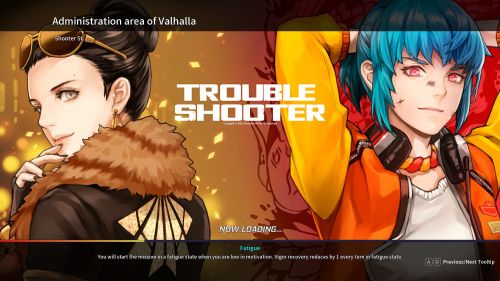
Considering the usual standard of anime art, this isn't the worst you'll ever see. It's about the only part of the game's anime tropes that isn't absolutely awful, though.
But we’re getting ahead of ourselves, aren’t we? What even is a fucking Troubleshooter: Abandoned Children?
One does not simply Troubleshooter: Abandoned Children
This game is completely impossible to explain. Even doing a video review that does its otherworldly weirdness justice would be a challenge. But I’m gonna put it in the simplest possible terms here and make an attempt:
In Troubleshooter: Abandoned Children you play a Troubleshooter – a sort of private detective entrepreneur with their own agency, police force and military branch who gets hired by both private contractors and the actual, governmental police to “solve cases” (which in this game's absurd writing logic doesn't mean "interview witnesses and track down evidence" but instead "shoot the shit out of bad guys").
The gameplay at its most simple is an anime version of nu-XCOM. You got your team of guys who do mission maps with turn-based combat, they have two action points, end their turn after "dashing" (i.e. using both of their two available action points to move) or after attacking, and can seek refuge from enemy bullets behind either half-cover or full-cover.
This is also how you’ll experience the beginning of the game – despite the Troubleshooter's many, many, many layers of complexity, it will feel remarkably familiar and easy to grasp at first.
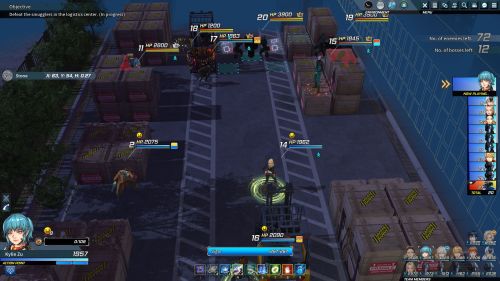
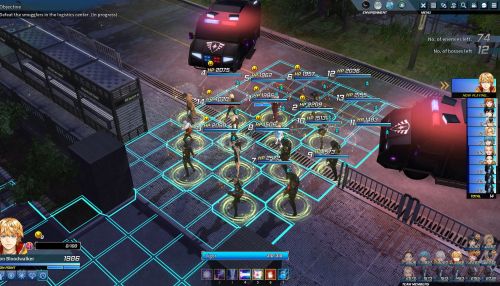
The HP bars are your first clue that this ain't your grandma's XCOM. The second would be the spray-can wielding femme fatale.
This won’t last long, though. For some reason, absolutely insane and constantly apologizing Korean-based developer DandyLion thought the above system – designed to simplify and boardgamify turn-based tactics – was the perfect foundation on which to build one of video gaming’s most complex and open-ended character systems. Characters have their standard to-hit rolls, but on top of this have Dodge values allowing them to completely avoid attacks, they have a Block value which is a chance to halve incoming damage, there’s an armor system that reduces physical attacks (and a resistance system for magical ones), direct damage reduction in addition to characters having class-based, personal, talent-based and item-based ways to further mitigate damage or disrupt damage-mitigation. There are critical hits, characters have to keep track of their Vigor to fuel their actions, there are abilities that modify what all these different systems actually do, like causing all attacks to be automatically blocked at certain health thresholds, and there are about fifty million buffs and debuffs, a ton of consumables, a vast array of abilities, items and much, much more.
The thing is: the above is really just the basic rules of how combat works. In reality, the meat of Troubleshooter’s combat – and character system – lies somewhere else entirely: in the game’s Mastery system.
The gist of it
This is where everything gets tricky, and where I'm going to start sounding more like I'm a deranged lunatic writing a strategy guide and less like an amateur video game reviewer. I'll try to describe this system as succinctly as possible and put my faith in the fact that the attention span of a Codexer is marginally longer than that of the average, internet troglodyte. So follow me, dear forum brother, as we descend down the stairway of incremental madness...
The beating heart of Troubleshooter’s interconnected web of system design is Masteries. At their base level, Masteries function much like feats in Dungeons & Dragons - that is, as your character gains levels, you pick more Masteries and add them to your character sheet. Unlike feats, though, masteries have a point cost, can be switched in and out almost freely at any point outside of missions, and each belongs to one of five types (Basic, Attack, Ability, Support or Defense). A character’s training points determine how many masteries they can equip – so, say, a character with 10 training points could equip Breakthrough (3 points), Final Blow (3 points) and Mutant (4 points). Furthermore, each character has a Property Limit for each type of mastery. If our character with 10 training points from before had an Attack Property Limit of 5, he wouldn’t be able to equip both Breakthrough (3 points) and Final Blow (3 points) despite having 10 training points, because they are both Attack masteries, sum up to 6 points and his Attack Property Limit is only 5.
Each mastery adds unique effects to your character – for example, the aforementioned Breakthrough halves the Block rating of anyone trying to defend against your attacks, while Mutant turns every single debuff affecting you into a random buff at the end of your turn – but the real twist here is that if you combine certain sets of four masteries, you activate a Mastery Set. These special sets add their own effects to your character which can be anything from just granting you a flat HP bonus, to modifying one or two of the masteries that activated it, adding entirely new abilities or passive effects to your character. These mastery sets are not shown anywhere until you discover them for yourself, and I highly encourage you to play Troubleshooter blind here – at least for the main game – as there’s a very puzzle solving-like joy in identifying and finding powerful mastery sets on your own.
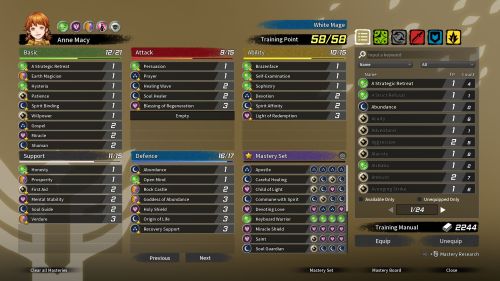
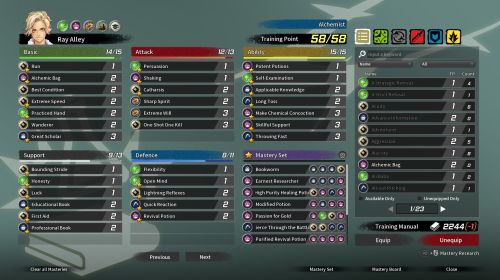
Here's Anne and Ray, mastery boards gloriously filled out. Activated mastery sets can be seen in the bottom right corner.
To draw another parallel to D&D, Mastery Sets are kind of like if you picked four feats in D&D and picking those specific, four feats added an additional, fifth feat to your character.
In addition, most of the masteries in Troubleshooter come from a shared pool of 'Common' masteries that can be equipped by any character with no prerequisites. There are class-, race- and type-masteries, but beyond those, masteries are a complete free-for-all.
Building any character in Troubleshooter: Abandoned Children is therefore a sprawling buffet of endless possibilities and combinations. You’re always chasing that perfect dream of activating the mastery sets you want while still having room for individually powerful masteries all the while having to obey property limits and spending your total, allotted training points. There’s no more inherently Troubleshooter feeling than missing just one mastery to activate a final set, meanwhile knowing that pulling out anything you’re already fielding is likely to start a domino-effect of deactivating synergies you’ve already put onto your mastery board. What any sensible person does in that situation, of course, is start completely over because if you just tweak that thing you considered before, then surely..?
It also means that you can build virtually any character in virtually any you want. Want to make the game’s default, squishy healer into your main tank? There’s almost certainly a way to do it – and in fact, the game will probably support it with a ton of masteries that enable weird and wonderful synergies exactly like that.
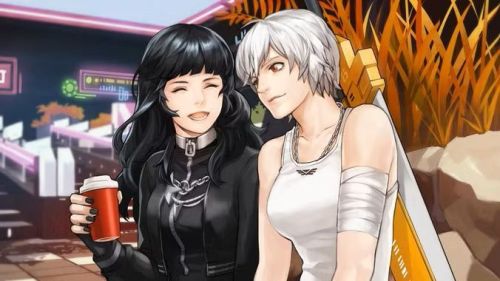
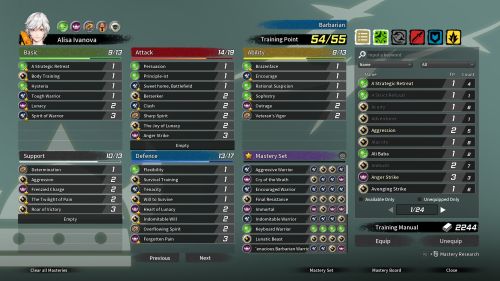
Alisa (pictured to the right of Bianca in the left picture) can choose between the 'White Knight' and 'Barbarian' advanced classes. Somewhere, ERYFKRAD let out a pleased grunt upon realizing this.
Yet even with all this freedom, a character’s base stats, core active abilities and masteries specific to their type will make sure that even though everyone shares this massive pool of hundreds (and hundreds, and again hundreds) of different masteries, they will still be unique. In fact, every character must choose from a whole host of class-specific masteries and advanced class masteries (which are selected from one of the two advanced classes your character can pick), as well as type-specific masteries - like Spirit masteries for Spirit-users or Fire masteries for Fire-users. On top of this, characters must choose one out of three individual, passive abilities and have base class- and advanced class passive abilities which are not part of the mastery board themselves, but which further individualize characters.
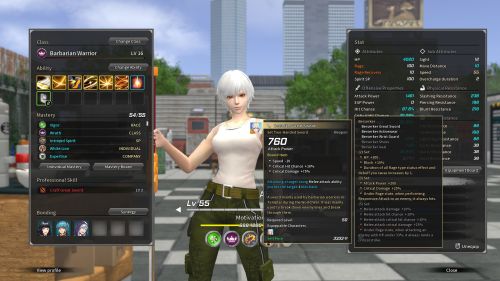
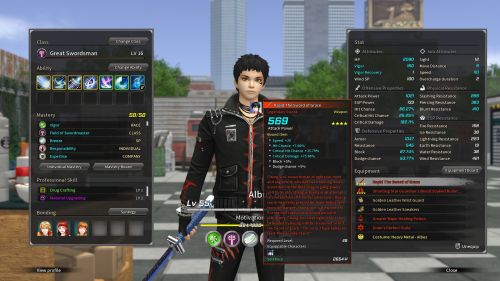
Note the box on the left labeled 'mastery'. Alisa's class mastery 'Wrath' - the passive class ability that doesn't take up space on her mastery board - is different from Albus' 'Field of Swordmaster' (there's that impeccable translation, by the way). Albus' three "individual masteries" are passive abilities unique to him alone, though he must pick one from among them to activate. This Albus runs 'Responsibility'. Alisa must also choose one out of three individual masteries - in this screenshot, she is running 'White Lion'.
From this complicated mesh of interactions between individualizing factors (a character’s active abilities which are unique to that character, individual masteries as well as race-, type- and class-specific masteries) and the general pool of masteries arises a beautiful symphony of character-building headaches: you can build just about anything but should always account for a character’s individual traits, which also includes the property limits on their mastery board. For instance, one character might naturally have more slots for Attack masteries than Defense masteries and while you can still build them as a tank - or rather, as someone who acts as a defensive "attack soaker" for your team - you’re going to have to rely on other synergies than just stacking Defense masteries alone. Your task will be possible – but you’ll have to get creative.
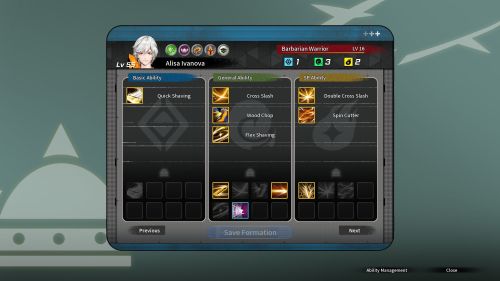
Alisa's active ability selection - these are the buttons she'll actually press in a mission to attack stuff. Some characters will also have active buffs or utility abilities, which would also be found here. As you can see, Alisa doesn't have room for all the abilities available to her, so she'll have to choose carefully. The number of slots in each category are related to her Advanced Class, which is Barbarian - White Knight has a different number of slots in the different categories.
For example, one of the party's main ranged attackers, Heixing, is a poor choice for a traditional armor tank soaking hits, but you CAN equip him with a ton of masteries that improve his defenses while in cover and in an elevated position. Doing this, you can effectively make him into a tank by placing him in key, strategic parts of the map where enemies will pour attacks into him with little success - all the while having to deal with a ton of automatic responsive fire from Heixing, if you choose to equip masteries that enable those as well. A nest of well-protected snipers might make mince-meat out of your entire team if you approach - but put Heixing with a cover-based fire support spec in a clever spot, and the whole host of long-range enemies will effectively kill themselves by trying to pry open the absolute unit that is Heixing in a nicely elevated position of cover.
As the game progresses, these systems only get more and more advanced. For instance, you’ll soon enough unlock a variety of racial meta-masteries – masteries that allow you to manipulate the property limits and number of type-slots on your mastery board.
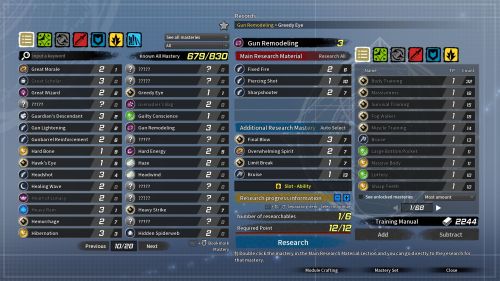
The mastery research screen, where you... well, you research masteries here, duh. This screen is much less complex than it looks - the entire process is automated unless you really, really want to do it manually.
The number of possibilities and ways to design your team is truly staggering – yet ingeniously not entirely endless. That last bit is important, because it means that there are always limitations in every nook and cranny of the game that prevent the character building from getting stale. You are trying to make a million things work within a set of clearly defined limitations, and that very challenge is where the fun of the character system comes from. It means that every build poses a unique challenge with its own strengths and puzzles.
Compared to something like Pathfinder’s feat system, not only are there many, many more masteries in Troubleshooter than feats in Pathfinder, Pathfinder’s feats also have limited synergy beyond how they work together in combat or what prerequisites they have. Everything in Troubleshooter ties together in a string of compounding synergies both from the rules enforced on the mastery board and mastery sets, and how the different synergies work with each other in actual combat. The system also boasts incredibly variety: Troubleshooter has nearly one thousand masteries (sic!) for you pick from.
The final, massive twist of the mastery system is this:
Masteries aren’t just acquired by leveling up. In fact, they're mainly acquired as item drops from enemies. What this means is that if you play Troubleshooter blind, any finished mission might send you back to the drawing board to tinker for minutes – maybe even hours – because just a couple of new masteries means you'll suddenly be incentivized to revise the builds of one or two characters - which of course cascades into perhaps wanting to adjust other characters as well. What this means is that in Troubleshooter, you absolutely should rework a few of your builds every couple of hours.
Don’t worry about missing vital masteries in the long run, though – there’s a way to guarantee that a certain mastery you’re looking for drops once you get later into the game.
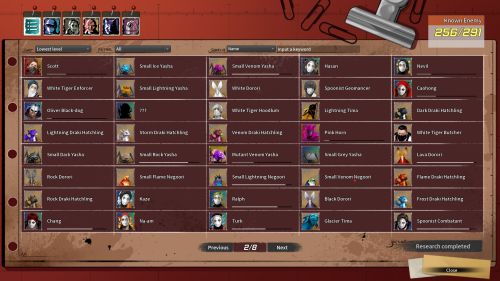
On the game's 'Troublemaker'-screen you can view individual enemies and find information about their stats, items and, more importantly: masteries.
This again ties into the comparison to Pathfinder. To paraphrase in-house determinism-fundamentalist lukaszek, in Pathfinder and other traditional RPGs, you typically plan your party once, at the start of the game, and then you simply follow that build plan. Or, alternatively, if you're more of a "roll with the punches" kind of filthy casual, at least once you've made a build decision during the game, that decision will be more or less final barring a complete respec. In Troubleshooter, building characters is a constant state of redesigning to meet current challenges and utilize newly gained masteries. In addition, many other RPGs don't provide you with a proper feedback loop on whether your build is actually any good. Instead, you either base your decision on a vague understanding of what is good right now, you try to predict the future based on your general RPG knowledge, or you cave in and use a guide. In Troubleshooter, respecs aren't some dirty mechanic implemented to save you from your own retardation - they're fundamentally baked into the game's design because the character building isn't just a personal choice about what character you want to make or what is "meta" - the character building is the constantly evolving gameplay challenge. Looking up a guide isn't even necessarily that much of a help, because there's a vast difference between how you'll want a given character to function 10 hours into the game vis a vis 90 hours into the game. As such, a functional guide would have to make a build for each 1 or 2 hours of gameplay.
For the same reason, you'll often see frustrated players on the game's Discord complain that they're following a build guide and that it doesn't work. That's because that guide was made for a max level character with access to all masteries - and even then, often for a specific scenario or mission type in the game - and trying to build level 17 Albus like a squishy chain-killer just won't cut it. You'll be much better off building him as a hybrid tank at that point - maybe even your primary.
As if this level of character building complexity wasn't enough, as the game goes on, you'll eventually unlock a total of 12 (!) party members, and many missions allow you to field every single one of them. Two of these can even summon pets, who you'll ALSO build from the ground up as unique characters. 9 party members are unlocked during the main game, 2 more are unlocked in the first DLC and then the final party member is unlocked in the last DLC. All of these characters have a base class, two advanced classes and a myriad of potential builds of their own.
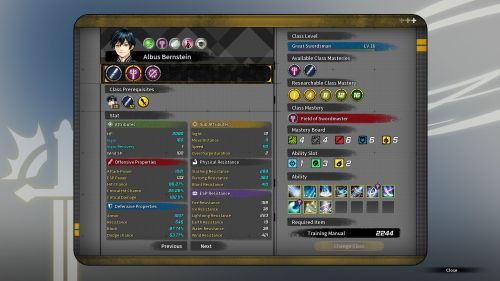
Albus' class screen. His base class, Swordsman, is the blue circle in the top left corner, below his portrait. On top of that, we've picked his advanced class, Great Swordsman, which is the purple circle in the middle (highlighted with a yellow circle). If we want to make him a Magic Knight (purple circle to the right of Great Swordsman), we'll have to drop Great Swordsman.
If you’re not into agonizing over character builds, what I just described will sound like your own, personal hell. But if you are 'sperging at the bit for a massive, ever-evolving character building challenge, you may just be one of the few unlucky souls that could fall into the depths of this game's system abyss.
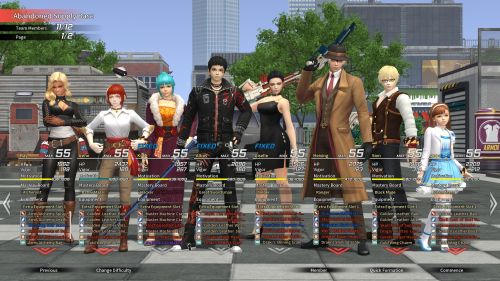
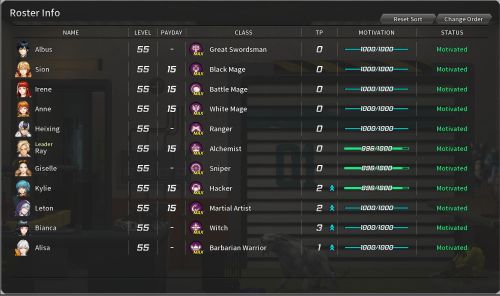
The squad selection screen (left) and the roster screen (right). This mission allows you to field the entire roster, but I still haven't started the final DLC on this playthrough, so I'm missing the final party member.
Some of the combinations you can unlock make your mind dizzy with the possibilities. You can build your tricksy Witch with Vindictive Spirits so that she possesses and mind controls all nearby enemies when she dies - except thanks to her Second AND Third Hearts, she'll revive and immediately take her turn after doing it! You can build your berserker Barbarian so that every time she gets hit, she'll run up to the nearest enemy and attack it - and if she gets a kill, the chain continues, all the while increasing her rage and making her briefly immortal if she reaches 1HP. You can ignore your sniper's main schtick and instead build her Hunter class as the ultimate utility box, buffing and getting buffed by her pets while spraying the battlefield with traps that inflict some of the nastiest status effects in the game that are normally extremely hard to access for the player. You can build a Flamethrower robot that doesn't do that much on its own turns - except you've filled its mastery board with Responsive attacks, meaning that if you stick it in a tight spot on the front line, you get to watch dozens of corpses pile up as they run into its zone of control, each activating one of the most deadly AoE attacks in the game over and over and over again until the Drone runs out of Responsive attacks or fuel.
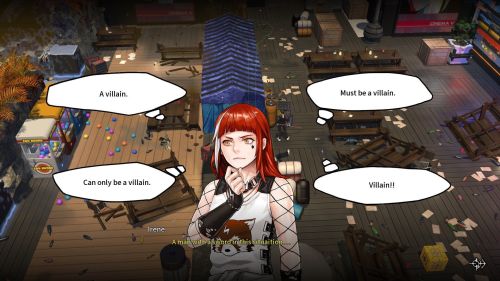
Irene's dedication to becoming a hero is a beloved meme among physically 40-year-old, mentally 12-year-old, men who enjoy Troubleshooter's writing. The above screen is about as endearing as the writing gets.
The ways in which Troubleshooter lets you manipulate abilities that don't look like much on their own into deadly chain synergies is absolutely staggering.
And this, this is the essence of why Troubleshooter is so goddamn fucking fantastic. There is no end to the things you can do, the things you want to do, with its character building. Its systems are so massive, expansive and intricate that every fresh mastery board fills you with endless optimism, and every actual execution mires you in a thought-swamp dragging you down with whispers of doubt that tell you that you could have done that a bit better, if only you tweaked this part or that part. Every hour of progress will reveal a new secret or teach you a new mechanic, every new enemy will do something unexpected making you want to get your hands on its masteries, and every progression of the main story will unlock side-missions that challenge your builds and keep your play conventions from becoming stale.
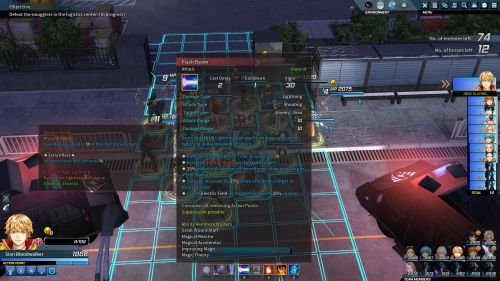
That's a lot of wording when they could have just put "Flash Beam go brrrrrr". Sion is one of the few characters with access to damaging abilities that hit a fairly wide area without being extremely restricted in range, consequently making him a favourite among newbies. Building him as a primary tank might be even more powerful, however.
At this point, you might be worried that all these combinations will completely break the game in half and kill any challenge it might offer, but this isn't really the case, especially if you play on its three, primary difficulty modes: Cruel, Challenge and High Risk, High Reward. Impressively, the game is relatively well balanced despite the incredible power its freedom affords you. Whenever you have those “Aha!” moments where you think you’ve outsmarted the game – and those come often in Troubleshooter – you’ll soon be faced with encounter design that'll show you that the developers saw your tricks coming a mile away and mitigated them with enemies who level the playing field.
I'm not saying Troubleshooter isn't breakable, of course. Any RPG is. I'm saying that considering the amount of power the game provides the player, it's remarkable it is more balanced than most of its simpler peers.
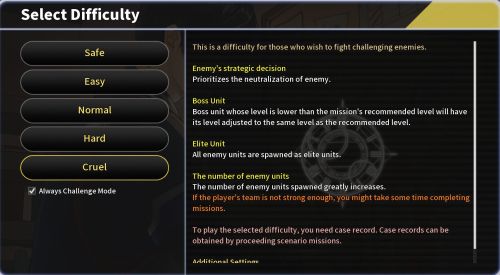
Like everything in the game, difficulty in Troubleshooter is complicated. There's the base choice which governs enemy AI, stats and abilities. But then there's a whole myriad of other, optional difficulty modes - I play with Challenge mode, which handles scaling, as well as High Risk, High Reward, Paranoid and Fetters of the Past, which add additional modifiers, masteries and relationship bonds to enemies.
In addition, Troubleshooter's active abilities - you know, the buttons you actually press to make enemy go boom boom - are remarkably restrained, often having low range, small AoE-potential or other disadvantages, which means there's often a limit to just how broken your broken combos will effectively be once you put them into practice on the battlefield. Troubleshooter is not a particularly difficult game, but it is very good at responding to the player’s increasingly vast power level with its own counterpunches.
Yo dawg, I heard you like systems, so I put a system in your system
Sounds complicated? Well, what I just described are merely the core systems of Troubleshooter. After playing 30-60 hours (depending on how much side-content you consume), already being glutted with the amount of system variety you’ve encountered beyond the masteries themselves, you'll meet Giselle, the team’s Sniper. Giselle can tame beasts, meaning she has the ability to make a permanent team member out of any of the games dozens of beast enemies – from the most tiny, puny bird-like creature to legendary dragons. Once a given beast is tamed, it is added to your roster – and you suddenly realize that this is not just a matter of copying whatever beast you tamed. No, you get to evolve this beast, which means choosing from a host of individualized masteries as well as building that beast’s own mastery board, maybe even selecting a unique class for it. Beasts have access to a sprawl of unique masteries – there’s a general pool of Beast masteries, they might have access to Elemental masteries and then there’s their own, unique type masteries (so dogs will have access to dog-masteries, dragons to dragon-masteries and so on). That’s in addition to, of course, having access to the giant pool of Common masteries that everyone has access to.
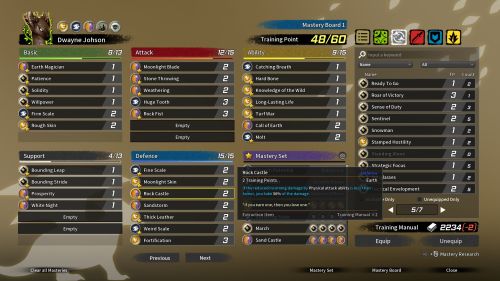
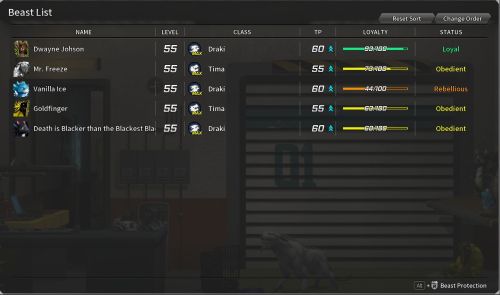
'Dwayne' here is my pet rock dragon. I'm in the process of working out his build. The left image shows my current Beast roster, which I'm in the process of developing.
Once you lose all hope of ever understanding the full breadth of the systems at this point, the game introduces Kylie – the team’s engineer. Now, you’re suddenly prompted to build her drones – robots that are even more complex and require you to select from a number of frames, operating systems, customized crafted weapons, armor, propulsion systems etc., as well as, of course, building out their mastery boards. Which, coincidentally, are entirely unique and share no overlap whatsoever with the rest of the game’s masteries.
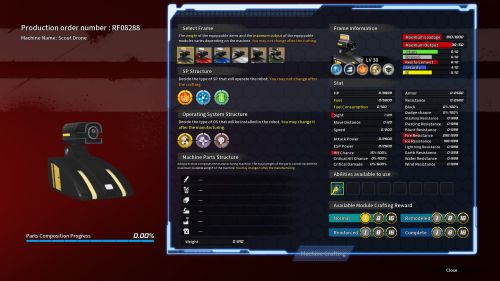
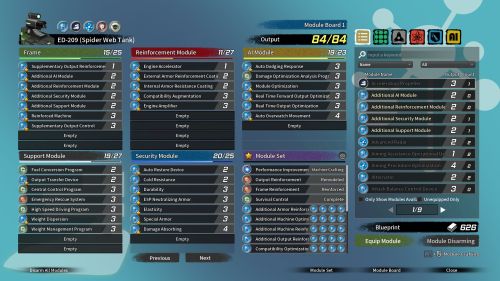
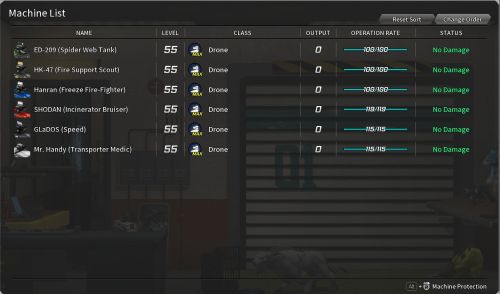
Building a robot (left), giving it masteries (middle - in this case, the mastery board belongs to ED-209, my drone tank that fires icky clumps of spider webbing at my enemies) and looking at my current roster of robots (right).
What. The. Fuck.
Did I say "crafted weapons", by the way? Yes of course – Troubleshooter indeed boasts a broad crafting system allowing you to craft almost anything, including set items, consumables and more. I say almost anything, because Troubleshooter recognizes that a crafting system with too much variety will pull the excitement out of item drops, and thus many unique items – and affixes – cannot be crafted. The result is that most builds end up using a variety of crafted sets, crafted items and drops.
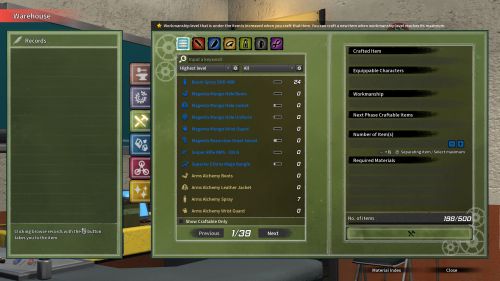
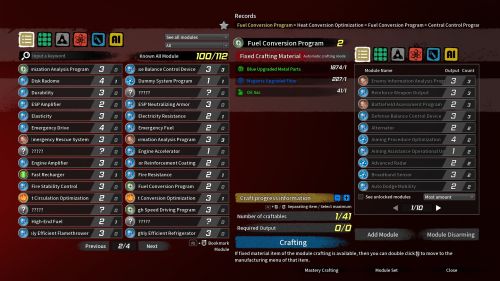
Understanding crafting is mercifully simple relative to most systems in Troubleshooter. You unlock new recipes by crafting older ones, and everything clearly states what ingredients are needed. All ingredients can be gained by upgrading lesser tiers, degrading higher tiers, or bought in stores, so you're never more than a click away from the materials you need. Modules, which are masteries for robots, have to be crafted as well (right-most picture).
Itemization itself is not the game's strongest suit, but it does have a lot of different unique items, item sets and item stats - enough so that later game gearing offers a vast array of enticing options.
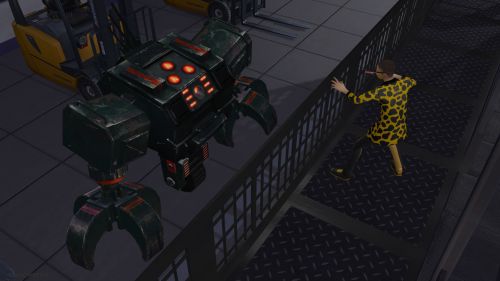
That there is a dangerous criminal dressed in a leopard dotted suit controlling a cool robot. Did I mention that anime ruins everything, even cool robots?
So far, I’ve mostly mentioned character building systems, though. Troubleshooter of course offers a variety of additional systems. You begin the game by choosing a Company Mastery – a unique ability that affects your company globally. Your company also begins with jurisdiction of just one district within the town of Valhalla, and as your company grows, you extend this jurisdiction to more districts. Building your renown within a specific district levels up your Reputation within that district, which allows you to choose different abilities that activate when you do missions within the district – or any other number of effects. These reputation levels are dynamic, meaning that your actions in the rest of the game raise and/or lower them from week to week.
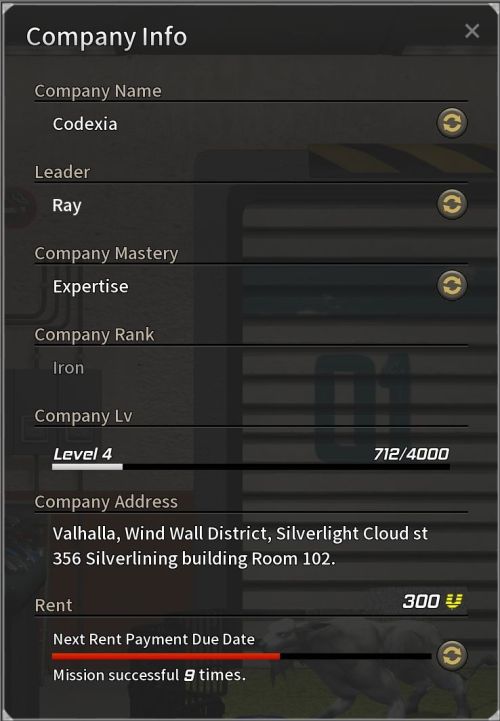
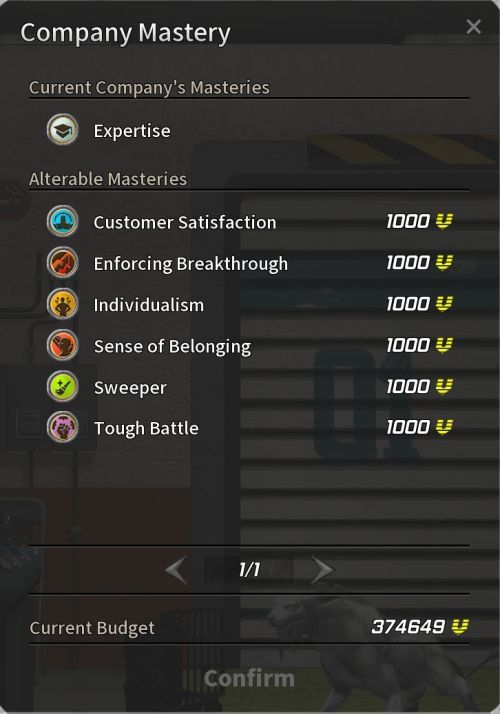
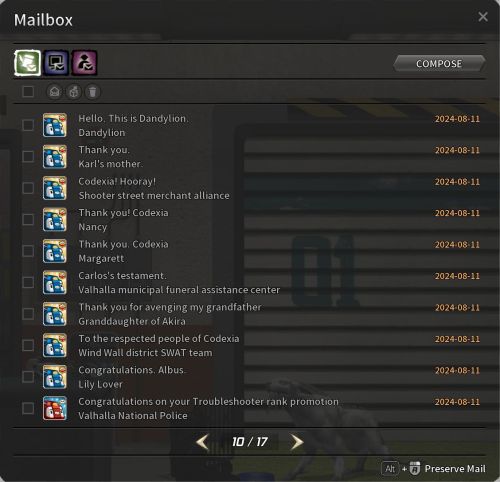
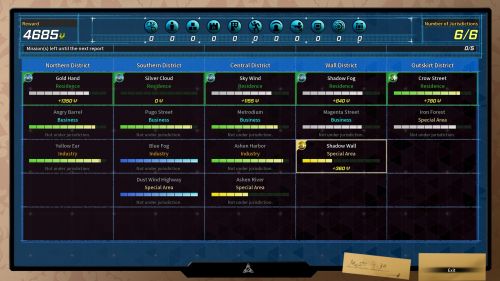
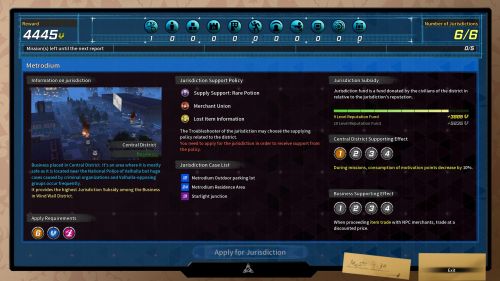
Systems within systems. Those last two screens are the jurisdiction thingymajig - first one is the overall jurisdiction screen, second is a zoom-in on one area. Still not sure I entirely understand that system, tbh. I just get all giddy when the numbers go up. Unfortunately, they can go down as well, the fuckers.
Characters also have a relationship level – and characters with a strong relationship bond unlock powerful synergies that activate when they fight together. You also build up relations with the game’s merchants, which unlocks more stock and gives discounts with said merchants.
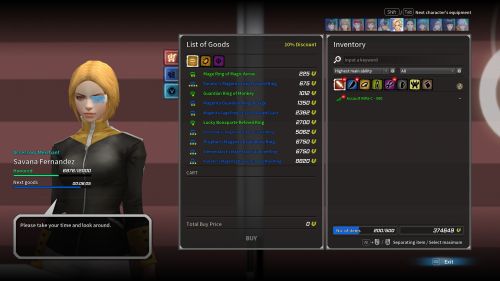
Merchant UI is simple and efficient. Most menu navigation in Troubleshooter is, actually, which is a massive mercy considering how often you will be navigating said menus.
What determines how party members regard one another is a laughably parodic example of how wild Troubleshooter's systems really get. Relationship status is chiefly increased by characters going on missions together, but what also factors in are a character's arcana, prefered working environment, policies, relationship outlook and - get this - zodiac. Yes, my friend: If you really want to understand character relations in Troubleshooter, you surely must lay their horoscope!
There are terrain type modifiers for each square on the battle map, there's a weather system (a mission might take place on a map that has the Snowy, Outdoors, Afternoon and Cold modifiers), zone control interactions, you can't summon pets in certain climates their type doesn't agree with...
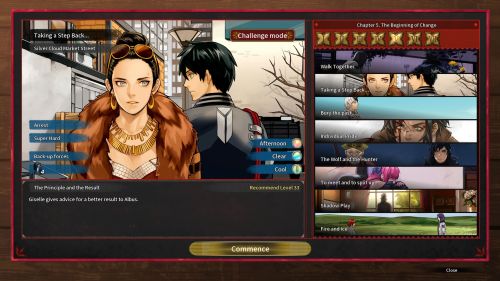
"What's the weather like today, mr. Cantore?" "Oh, I'd say clear skies with a chance of increased critical hit chance for Fire and Earth Attacks, my good man."
I could go on listing these systems and take the tl;dr-ness of a Codex-review to unheard of levels, but then I'd wager your eyes are already glazed over and your mind slowly wandering to nicer thoughts, such as that time you french-kissed Liza from Biology behind the janitor's shed, so let's leave it at this.
That's an elephant
Now I hear that heretical thought pounding on the inside of your brain: "This sounds like the worst case of systems bloat I have ever heard of." And, well, yes. But also... no? Let me explain.
There are some systems that are more or less superfluous. Rather than an injury system, the game regulates characters tiring from combat with a Motivation system. Remotivating your characters is a simple matter of spending pennies on food. Said food has its own subsystem; combining different food gives buffs that last for the first few rounds of a mission (and of course, there are masteries that can interact with these systems…). These smaller subsystems are less of an annoyance than they might sound like because interaction with them rarely takes more than 2-4 seconds, but that’s also what makes them feel superfluous in comparison to more meaningful systems in the game. As such: yes, these systems are bloat, but they are not intrusive or annoying enough that it weighs the game down in any meaningful way.
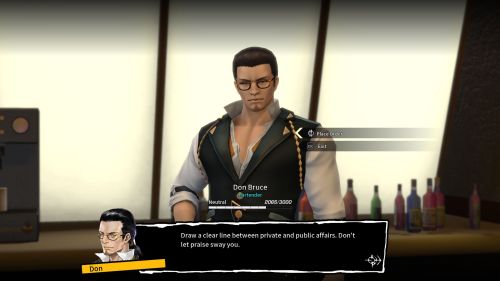
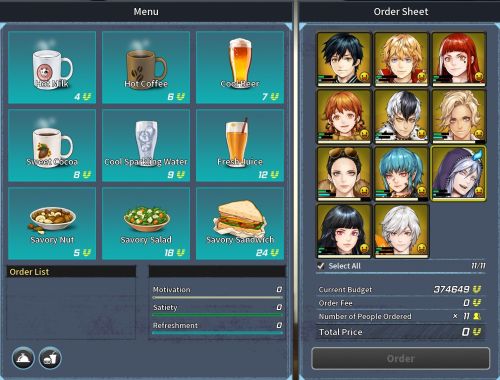
Ain't nothing like a sandwich from good ol' Don here to fix the leftover sadness of being stuck in an anime video game fighting scoundrels with handaxes. If you're really in a bad way, consider mixing water, juice and beer for a Speed buff in the next map - kids can't drink alcohol though, so Anne can't partake in this combo (YARSIIT - Yet Another Rules System Implementation In Troubleshooter).
On the flip side, many of the game’s subsystems are completely unintrusive, intuitive and meaningful. One of these is the ‘Troublemaker’ system. Much like in other games, when you defeat enemies, you learn more about them, unlocking data on them in a journal. While this system isn’t exactly novel, it has more depth than in most other games. Unlocking different knowledge tiers about a given enemy not only gives you information on them and combat bonuses against them, but also gives you information about unique masteries they might have, increases drop chances and finally, at the last tier, guarantees unlocking their unique mastery (or masteries). This last bit is important in the late game, when you might just need a couple of very specific masteries for the build you’re doing.
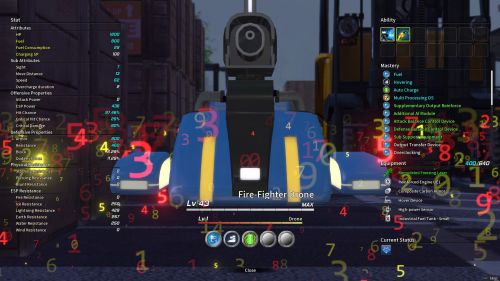
We know such detailed info about this enemy drone because we've fought it before, see. Unlike many other games where looking at this info will effectively never be necessary, a lot of this game's enemies can have very nasty defenses or attacks that you'll have difficulty countering on the highest difficulty if you don't take a peek at how it all actually works.
I could spend the rest of this review discussing the game’s itemization systems, how some masteries aren’t dropped but are unlocked through achievements, dialogue choices, or interacting with game systems (like training specific pets), the intricacies of how the game assists you in finding mastery sets you’re close to discovering, the way it achieves a fairly deep enemy variety through interlacing systems already in place for the player character or the myriad of ways in which tiny, easily overlooked unique character traits can open up entirely new build paths if you look hard enough.
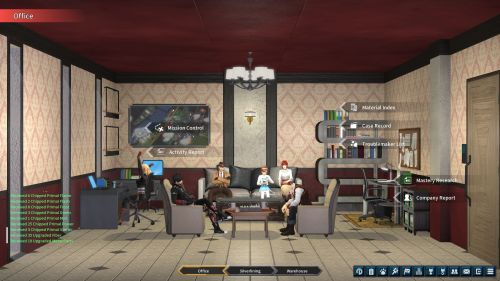
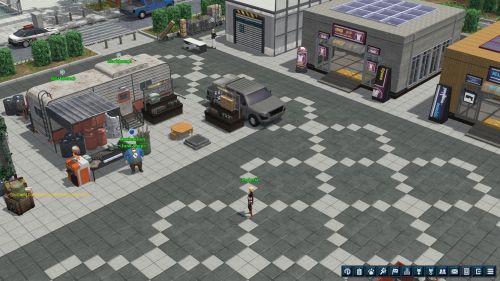
Main bulk of the crew hangs out in the office (left). Other areas in the hub world between missions include the bar 'Silverlining', the warehouse (where crafting is done) and 'Shooter Street' (part of it pictured right), a larger main hub with merchants galore and a stash for extra gear.
The point is this, though: Actually playing Troubleshooter feels less bloated that you'd think given the breadth of systems on display - but that still doesn't mean it isn't catered extremely specifically to a crowd of character customization maniacs, and at this point in the review, you’ll already know if that is you or if this game sounds like the definition of absolute tediousness to you. If your interest is piqued, however, you’ll maybe want to know how the game actually goddamn plays, in which case, well, let’s get to that shit.
What you actually do
Besides spending the better part of your free time sorting through billions of combinations on various mastery boards, the gameplay loop is staggeringly simple. You go to the game’s mission board and pick a mission out of the small handful of types:
Scenario cases, which progress the main story.
Ordinary cases, which are your most basic type of side mission.
Requested cases, which are missions specifically related to a side-quest you accepted in the game's hub area.
And Violent cases, which are mega-missions that have you duke it out against a dozen of the game’s bosses and often 50+ normal enemies. These missions are huge and can take hours to complete if you're dead set on clearing it all in one go - but generally allow you to stop after killing the one or two bosses you wanted to target.
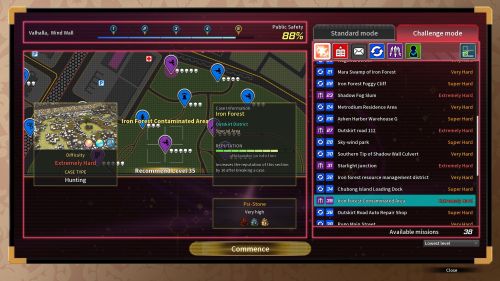
Ye olde mission select screen... don't look too long at it, or you'll just see a bunch of terminology I haven't brought up in the review, making you realize that there are a bunch of systems I've not even mentioned. What's a psi-stone, you ask? Better not think about it.
Once you’ve chosen your mission you go through a short cutscene presenting it (which can be skipped), after which you’ll more than likely be presented with a dialogue choice offering you 2-4 ways of approaching it (usually determining your starting location on the map, but sometimes more involved). From here, you’ll be presented with one of the game’s few gameplay weaknesses: its pathetically low mission type pool. While maps and enemies are plenty varied, you’ll most likely have to either clear all enemies or in rare cases save a few civilians or accomplish one or two other such stock tactical game mission goals to proceed. This is another reason why this game so specifically caters to the character customization crowd: there's little here to entertain you save building characters and fighting. Unless you enjoy the juvenile, poorly translated trash heap of a story or its collection of melodramatic anime characters, in which case: may God have mercy on your soul. I, for one, will not.
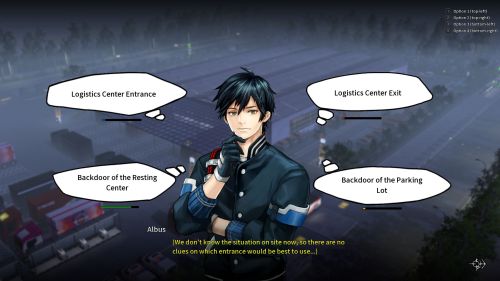
How to tackle this mission? Maybe we'll go in from behind - I've got Kylie specced as a Hacker, so she just might be able to give us the old surprise edge. It's gonna be crawling with enemies compared to the other entrances, though.
Fortunately, a lot of thought has gone into making sure maps and enemies take advantage of the game’s systems. Chunky enemies will force you to research ways to break down a variety of different defensive strategies, snipers fire off a barrage of reaction shots from well-guarded, elevated nests and must be dealt with through a mix of your own defensive strategies, smoke grenades and utility abilities. Sword-wielders will thrash your defenses unless you find a way to deal with them first - approaching them in melee can be lethal. Mages will buff groups of enemies and nuke your squishy party members. Some enemies trigger explosions on death which will chain-stun your dudes, rendering your meticulous network of defenses worthless. Crabs burrow and hide themselves, so how do you reliably reveal them? Some missions have vast, open areas, invalidating the cover-to-cover strategy for your squishy fire support guys. Another map swarms your otherwise immortal Battle Mage Irene with so many mobs and attacks that her "initiative" (called Action Time in the game's terminology) gets dumpstered and she never gets a turn... unless of course you equipped her with the Deep Sea Escape mastery which will allow her to take her turn instantly if it drops low enough in the turn order, turning a disadvantage into an advantage instead. Otherwise, maybe it's time to turn Sion, who you've otherwise used as a glass cannon nuker, into your main tank, since he also has access to the Battle Mage class and, unlike Irene, can mitigate the penalty to turn value accrued by dodging and blocking attacks. Of course if you do that, you won't get the benefits of Irene's amazing Hero buff on your Battle Mage...
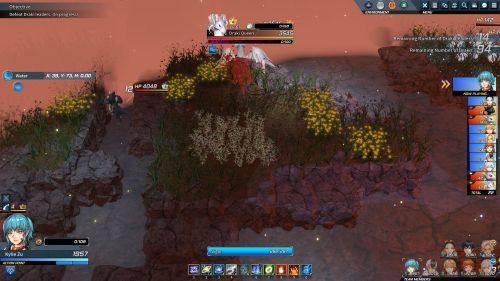
Better make sure those eggs don't hatch... maybe snatch one to keep and evolve it into a pet dragon?
All these problems are easily dealt with on their own because your mastery board is so flexible, but the trouble is that you cannot possibly find room to deal with it all on any given mastery board. So instead, you specialize. You drop your standard healer build on Anne and turn her into a debuff-stripping Witch, you morph Albus from the defensive counterattack-style that worked so well for you in the beginning into a hyper-fast chain-killer for the chaff, you put Machine Hunter on Heixing and tweak a few mastery sets so suddenly he is no longer your primarily AoE trash killer but the one who softens up the heavy duty guys so Bianca and her lethal Wind Witch build can sweep in with massive damage for the kill.
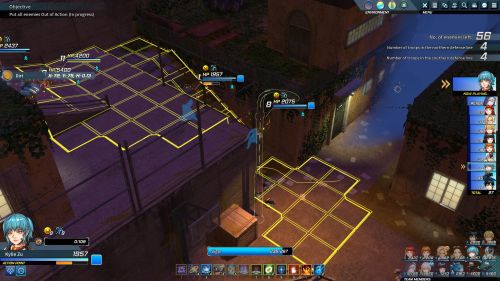
Elevation and terrain plays a big part in the game's map design and combat, and access to mobility skills is very limited.
In addition, missions - especially story missions - sometimes present you with diverging paths where different characters experience the mission from different points of view. Other missions may have different story choices that lead to different mission goals or results. Yet other missions don't necessarily fail just because you "failed" the mission, but instead lead to different outcomes. For example, one mission has a main character fight one of his former friends, and if you lose, the outcome furthers the story and you gain one reward, while winning will lead to another outcome. For those who just want to experience the game a single time, going through a mission just once with a single result is more than possible, while for ultimate completionists, ANY mission in Troubleshooter can be replayed as many times as one wants to fill out Troublemaker information, gain desired masteries or realize the results of different choices within a mission.
This also ties into a potential problem with Troublemaker. If you're fine rolling with what the game gives you, Troubleshooter doesn't have to be that grindy; you can finish everything from the first mission to the last never touching any mission more than once. But if you find info on a mastery you'd like that didn't drop from a boss during your first playthrough of a mission, or a piece of loot, or a beast you wanted to tame, you're going to have to replay that mission. Maybe even multiple times. So again: if you're a completionist or just someone who gets tics from not having access to the game's complete suite of items and abilities, Troubleshooter will suddenly become one of the grindiest single player games you have EVER played. Even if you don't have to complete everything, you'll more than likely want to replay quite a few missions a few times for a desired outcome or mastery.
In the end, Troubleshooter boils down to a simple gameplay loop, despite all its intricacies. Because it essentially only offers deep system customization and decent combat, but absolute dogshit everything else, your enjoyment of it relies solely on whether this loop is enough for you. On the bright side, there's nothing saying you have to grind out everything here - there's a shitton of content if you just play through 60% of the missions and only do those missions once. On the other hand, if you get the Troubleshooter bug and want to play with all of its toys, buckle up for some grinding that will make World of Warcraft seem like a short trip to the coffee shop down on the corner.
This is a good time to bring up another warning: Troubleshooter is massive. You might only have unlocked 4 characters after your first 30-40 hours of playing - and remember, there are 12 of these sons of bitches. Even if you sprint through the main quest on the lowest difficulty setting, you're likely to spend 70-80 hours with the game. Weaving in sporadic side-stuff, you're looking at 100. Doing all missions at least once? Maybe 150. Doing everything and unlocking everything? Forgetaboutit. You'll be playing nothing but Troubleshooter until the end of your days. According to Steam, I've spent 308 hours in Troubleshooter thus far, and I'm not even close to filling out the Troublemaker list. Those 308 hours are pathetic in comparison to some of this game's most dedicated fans.
Is Troubleshooter really the best game ever?
No. God no. No, no, no. The story is terrible, the writing is insulting, the aesthetics are juvenile, the mission variety is non-existent, a few of the game’s systems are superfluous at best and intrusive bloat at worst and it can be intensely grindy in the shittiest, most JRPG fashion possible. For all the favorable comparisons I've made to Owlcat's games, at least those games allow you put their bloated management content on auto. Troubleshooter will offer no such abeyance of its content barrage.
But, also? Yes. Yes it absolute is the best game ever.
Troubleshooter caters more specifically and with greater results to the character customization fetishist in all of us than any other game I’ve played. All while being a suprisingly balanced experience, all things considered. That last bit is particularly important, because all that character customization would ultimately be pointless if the game was too easy to break, or if it was too easy to just pick a strategy early and spam it endlessly for the rest of the game. Like any RPG, Troubleshooter can be munchkinned to absolute death, but given the depth of its systems, it's fairly impressive how little restraint you have to show in order to avoid cheesing it. Or in other words: for most of the punches you can throw, the game will present an at least somewhat adequate answer. You can break the game in multiple ways and still have it fight back if you avoid just a scant few of the most over-the-top interactions. Troubleshooter also manages to make most of its build combinations viable even on its hardest difficulties, which, of course, is even more important.
This is the sole reason Troubleshooter has won the dubious honor of being the single-player game I’ve played the most hours of, at least according to Steam (though of course, Steam can't count the childhood I lost to Baldur's Gate and Might & Magic VII).
So no, Troubleshooter is not the best game ever made. But it might just be the most addictive one yet made for those of us who think the most intoxicating part of playing an RPG is the endless amount of time spent in character creation, agonizing for hours upon hours about every little decision.
I fucking hate anime. I hate the exaggerated art style, I hate the androgynous, omega-cucked protagonists, I hate the hyper-fixation on (and sexualization of) child characters who participate in the drama on the same level as the adults, I hate the nonsensical storytelling and I hate the juvenile combination of cartoon silliness and world-shattering melodrama that always seems to haunt every bit of writing in the genre.
So when I tell you that I have put a categorically shameful number of hours into my two playthroughs of Troubleshooter: Abandoned Children, despite the fact that it ranks among the worst offenders in the history of anime in most of the areas above (the art is… well, it’s fine for the genre), I want you to understand what this means about how insanely addictive the gameplay can be. I am putting up with what is perhaps the most incoherent, crackbrained, idiotic, loose-threaded story told in video game history and with writing so terrible and poorly translated it will make your 5-year-old cousin Billy's "and then..."-stories seem like poetic masterpieces, because this game is just that fucking great at tickling my brain in all its funny spots.

Yes, of course the girl on the right is a party member and yes of course she's friends with a chainsaw-wielding, pink-haired master assassin of the same age...
Fair warning, though: while Troubleshooter is so bloody amazing it has obtained a license to drive some of the most terrible anime tropes directly into my eyeballs on a daily basis despite my utter disdain for it, it is that bloody amazing in a very particular way that doesn’t cater to just any video game fan – hell, I'd wager it won't even cater to half of the otherwise monocled autists on this here prestigious website.
Troubleshooter is, first and foremost, one of those system-heavy games that didn’t meet a mechanic it couldn’t regulate with a bloated, customizable ruleset. Troubleshooter allows for flexible, deep character tinkering in a way that shames most other competitors in the genre. The obvious, direct competition would be Owlcat’s Pathfinder games, which compromise on just about anything, including basic playability, to make sure the creatively mad scientist munchkin inside of you gets to realize his wildest character-building dreams within a sprawling RPG system. Even still, I can say with utter conviction that if you’re seeking a character builder's dream, pilgrim, Troubleshooter will wipe the absolute floor with Pathfinder. Not only because the systems are simply more interesting, but because they are more customizable and there are more of them.

Considering the usual standard of anime art, this isn't the worst you'll ever see. It's about the only part of the game's anime tropes that isn't absolutely awful, though.
But we’re getting ahead of ourselves, aren’t we? What even is a fucking Troubleshooter: Abandoned Children?
One does not simply Troubleshooter: Abandoned Children
This game is completely impossible to explain. Even doing a video review that does its otherworldly weirdness justice would be a challenge. But I’m gonna put it in the simplest possible terms here and make an attempt:
In Troubleshooter: Abandoned Children you play a Troubleshooter – a sort of private detective entrepreneur with their own agency, police force and military branch who gets hired by both private contractors and the actual, governmental police to “solve cases” (which in this game's absurd writing logic doesn't mean "interview witnesses and track down evidence" but instead "shoot the shit out of bad guys").
The gameplay at its most simple is an anime version of nu-XCOM. You got your team of guys who do mission maps with turn-based combat, they have two action points, end their turn after "dashing" (i.e. using both of their two available action points to move) or after attacking, and can seek refuge from enemy bullets behind either half-cover or full-cover.
This is also how you’ll experience the beginning of the game – despite the Troubleshooter's many, many, many layers of complexity, it will feel remarkably familiar and easy to grasp at first.


The HP bars are your first clue that this ain't your grandma's XCOM. The second would be the spray-can wielding femme fatale.
This won’t last long, though. For some reason, absolutely insane and constantly apologizing Korean-based developer DandyLion thought the above system – designed to simplify and boardgamify turn-based tactics – was the perfect foundation on which to build one of video gaming’s most complex and open-ended character systems. Characters have their standard to-hit rolls, but on top of this have Dodge values allowing them to completely avoid attacks, they have a Block value which is a chance to halve incoming damage, there’s an armor system that reduces physical attacks (and a resistance system for magical ones), direct damage reduction in addition to characters having class-based, personal, talent-based and item-based ways to further mitigate damage or disrupt damage-mitigation. There are critical hits, characters have to keep track of their Vigor to fuel their actions, there are abilities that modify what all these different systems actually do, like causing all attacks to be automatically blocked at certain health thresholds, and there are about fifty million buffs and debuffs, a ton of consumables, a vast array of abilities, items and much, much more.
The thing is: the above is really just the basic rules of how combat works. In reality, the meat of Troubleshooter’s combat – and character system – lies somewhere else entirely: in the game’s Mastery system.
The gist of it
This is where everything gets tricky, and where I'm going to start sounding more like I'm a deranged lunatic writing a strategy guide and less like an amateur video game reviewer. I'll try to describe this system as succinctly as possible and put my faith in the fact that the attention span of a Codexer is marginally longer than that of the average, internet troglodyte. So follow me, dear forum brother, as we descend down the stairway of incremental madness...
The beating heart of Troubleshooter’s interconnected web of system design is Masteries. At their base level, Masteries function much like feats in Dungeons & Dragons - that is, as your character gains levels, you pick more Masteries and add them to your character sheet. Unlike feats, though, masteries have a point cost, can be switched in and out almost freely at any point outside of missions, and each belongs to one of five types (Basic, Attack, Ability, Support or Defense). A character’s training points determine how many masteries they can equip – so, say, a character with 10 training points could equip Breakthrough (3 points), Final Blow (3 points) and Mutant (4 points). Furthermore, each character has a Property Limit for each type of mastery. If our character with 10 training points from before had an Attack Property Limit of 5, he wouldn’t be able to equip both Breakthrough (3 points) and Final Blow (3 points) despite having 10 training points, because they are both Attack masteries, sum up to 6 points and his Attack Property Limit is only 5.
Each mastery adds unique effects to your character – for example, the aforementioned Breakthrough halves the Block rating of anyone trying to defend against your attacks, while Mutant turns every single debuff affecting you into a random buff at the end of your turn – but the real twist here is that if you combine certain sets of four masteries, you activate a Mastery Set. These special sets add their own effects to your character which can be anything from just granting you a flat HP bonus, to modifying one or two of the masteries that activated it, adding entirely new abilities or passive effects to your character. These mastery sets are not shown anywhere until you discover them for yourself, and I highly encourage you to play Troubleshooter blind here – at least for the main game – as there’s a very puzzle solving-like joy in identifying and finding powerful mastery sets on your own.


Here's Anne and Ray, mastery boards gloriously filled out. Activated mastery sets can be seen in the bottom right corner.
To draw another parallel to D&D, Mastery Sets are kind of like if you picked four feats in D&D and picking those specific, four feats added an additional, fifth feat to your character.
In addition, most of the masteries in Troubleshooter come from a shared pool of 'Common' masteries that can be equipped by any character with no prerequisites. There are class-, race- and type-masteries, but beyond those, masteries are a complete free-for-all.
Building any character in Troubleshooter: Abandoned Children is therefore a sprawling buffet of endless possibilities and combinations. You’re always chasing that perfect dream of activating the mastery sets you want while still having room for individually powerful masteries all the while having to obey property limits and spending your total, allotted training points. There’s no more inherently Troubleshooter feeling than missing just one mastery to activate a final set, meanwhile knowing that pulling out anything you’re already fielding is likely to start a domino-effect of deactivating synergies you’ve already put onto your mastery board. What any sensible person does in that situation, of course, is start completely over because if you just tweak that thing you considered before, then surely..?
It also means that you can build virtually any character in virtually any you want. Want to make the game’s default, squishy healer into your main tank? There’s almost certainly a way to do it – and in fact, the game will probably support it with a ton of masteries that enable weird and wonderful synergies exactly like that.


Alisa (pictured to the right of Bianca in the left picture) can choose between the 'White Knight' and 'Barbarian' advanced classes. Somewhere, ERYFKRAD let out a pleased grunt upon realizing this.
Yet even with all this freedom, a character’s base stats, core active abilities and masteries specific to their type will make sure that even though everyone shares this massive pool of hundreds (and hundreds, and again hundreds) of different masteries, they will still be unique. In fact, every character must choose from a whole host of class-specific masteries and advanced class masteries (which are selected from one of the two advanced classes your character can pick), as well as type-specific masteries - like Spirit masteries for Spirit-users or Fire masteries for Fire-users. On top of this, characters must choose one out of three individual, passive abilities and have base class- and advanced class passive abilities which are not part of the mastery board themselves, but which further individualize characters.


Note the box on the left labeled 'mastery'. Alisa's class mastery 'Wrath' - the passive class ability that doesn't take up space on her mastery board - is different from Albus' 'Field of Swordmaster' (there's that impeccable translation, by the way). Albus' three "individual masteries" are passive abilities unique to him alone, though he must pick one from among them to activate. This Albus runs 'Responsibility'. Alisa must also choose one out of three individual masteries - in this screenshot, she is running 'White Lion'.
From this complicated mesh of interactions between individualizing factors (a character’s active abilities which are unique to that character, individual masteries as well as race-, type- and class-specific masteries) and the general pool of masteries arises a beautiful symphony of character-building headaches: you can build just about anything but should always account for a character’s individual traits, which also includes the property limits on their mastery board. For instance, one character might naturally have more slots for Attack masteries than Defense masteries and while you can still build them as a tank - or rather, as someone who acts as a defensive "attack soaker" for your team - you’re going to have to rely on other synergies than just stacking Defense masteries alone. Your task will be possible – but you’ll have to get creative.

Alisa's active ability selection - these are the buttons she'll actually press in a mission to attack stuff. Some characters will also have active buffs or utility abilities, which would also be found here. As you can see, Alisa doesn't have room for all the abilities available to her, so she'll have to choose carefully. The number of slots in each category are related to her Advanced Class, which is Barbarian - White Knight has a different number of slots in the different categories.
For example, one of the party's main ranged attackers, Heixing, is a poor choice for a traditional armor tank soaking hits, but you CAN equip him with a ton of masteries that improve his defenses while in cover and in an elevated position. Doing this, you can effectively make him into a tank by placing him in key, strategic parts of the map where enemies will pour attacks into him with little success - all the while having to deal with a ton of automatic responsive fire from Heixing, if you choose to equip masteries that enable those as well. A nest of well-protected snipers might make mince-meat out of your entire team if you approach - but put Heixing with a cover-based fire support spec in a clever spot, and the whole host of long-range enemies will effectively kill themselves by trying to pry open the absolute unit that is Heixing in a nicely elevated position of cover.
As the game progresses, these systems only get more and more advanced. For instance, you’ll soon enough unlock a variety of racial meta-masteries – masteries that allow you to manipulate the property limits and number of type-slots on your mastery board.

The mastery research screen, where you... well, you research masteries here, duh. This screen is much less complex than it looks - the entire process is automated unless you really, really want to do it manually.
The number of possibilities and ways to design your team is truly staggering – yet ingeniously not entirely endless. That last bit is important, because it means that there are always limitations in every nook and cranny of the game that prevent the character building from getting stale. You are trying to make a million things work within a set of clearly defined limitations, and that very challenge is where the fun of the character system comes from. It means that every build poses a unique challenge with its own strengths and puzzles.
Compared to something like Pathfinder’s feat system, not only are there many, many more masteries in Troubleshooter than feats in Pathfinder, Pathfinder’s feats also have limited synergy beyond how they work together in combat or what prerequisites they have. Everything in Troubleshooter ties together in a string of compounding synergies both from the rules enforced on the mastery board and mastery sets, and how the different synergies work with each other in actual combat. The system also boasts incredibly variety: Troubleshooter has nearly one thousand masteries (sic!) for you pick from.
The final, massive twist of the mastery system is this:
Masteries aren’t just acquired by leveling up. In fact, they're mainly acquired as item drops from enemies. What this means is that if you play Troubleshooter blind, any finished mission might send you back to the drawing board to tinker for minutes – maybe even hours – because just a couple of new masteries means you'll suddenly be incentivized to revise the builds of one or two characters - which of course cascades into perhaps wanting to adjust other characters as well. What this means is that in Troubleshooter, you absolutely should rework a few of your builds every couple of hours.
Don’t worry about missing vital masteries in the long run, though – there’s a way to guarantee that a certain mastery you’re looking for drops once you get later into the game.

On the game's 'Troublemaker'-screen you can view individual enemies and find information about their stats, items and, more importantly: masteries.
This again ties into the comparison to Pathfinder. To paraphrase in-house determinism-fundamentalist lukaszek, in Pathfinder and other traditional RPGs, you typically plan your party once, at the start of the game, and then you simply follow that build plan. Or, alternatively, if you're more of a "roll with the punches" kind of filthy casual, at least once you've made a build decision during the game, that decision will be more or less final barring a complete respec. In Troubleshooter, building characters is a constant state of redesigning to meet current challenges and utilize newly gained masteries. In addition, many other RPGs don't provide you with a proper feedback loop on whether your build is actually any good. Instead, you either base your decision on a vague understanding of what is good right now, you try to predict the future based on your general RPG knowledge, or you cave in and use a guide. In Troubleshooter, respecs aren't some dirty mechanic implemented to save you from your own retardation - they're fundamentally baked into the game's design because the character building isn't just a personal choice about what character you want to make or what is "meta" - the character building is the constantly evolving gameplay challenge. Looking up a guide isn't even necessarily that much of a help, because there's a vast difference between how you'll want a given character to function 10 hours into the game vis a vis 90 hours into the game. As such, a functional guide would have to make a build for each 1 or 2 hours of gameplay.
For the same reason, you'll often see frustrated players on the game's Discord complain that they're following a build guide and that it doesn't work. That's because that guide was made for a max level character with access to all masteries - and even then, often for a specific scenario or mission type in the game - and trying to build level 17 Albus like a squishy chain-killer just won't cut it. You'll be much better off building him as a hybrid tank at that point - maybe even your primary.
As if this level of character building complexity wasn't enough, as the game goes on, you'll eventually unlock a total of 12 (!) party members, and many missions allow you to field every single one of them. Two of these can even summon pets, who you'll ALSO build from the ground up as unique characters. 9 party members are unlocked during the main game, 2 more are unlocked in the first DLC and then the final party member is unlocked in the last DLC. All of these characters have a base class, two advanced classes and a myriad of potential builds of their own.

Albus' class screen. His base class, Swordsman, is the blue circle in the top left corner, below his portrait. On top of that, we've picked his advanced class, Great Swordsman, which is the purple circle in the middle (highlighted with a yellow circle). If we want to make him a Magic Knight (purple circle to the right of Great Swordsman), we'll have to drop Great Swordsman.
If you’re not into agonizing over character builds, what I just described will sound like your own, personal hell. But if you are 'sperging at the bit for a massive, ever-evolving character building challenge, you may just be one of the few unlucky souls that could fall into the depths of this game's system abyss.


The squad selection screen (left) and the roster screen (right). This mission allows you to field the entire roster, but I still haven't started the final DLC on this playthrough, so I'm missing the final party member.
Some of the combinations you can unlock make your mind dizzy with the possibilities. You can build your tricksy Witch with Vindictive Spirits so that she possesses and mind controls all nearby enemies when she dies - except thanks to her Second AND Third Hearts, she'll revive and immediately take her turn after doing it! You can build your berserker Barbarian so that every time she gets hit, she'll run up to the nearest enemy and attack it - and if she gets a kill, the chain continues, all the while increasing her rage and making her briefly immortal if she reaches 1HP. You can ignore your sniper's main schtick and instead build her Hunter class as the ultimate utility box, buffing and getting buffed by her pets while spraying the battlefield with traps that inflict some of the nastiest status effects in the game that are normally extremely hard to access for the player. You can build a Flamethrower robot that doesn't do that much on its own turns - except you've filled its mastery board with Responsive attacks, meaning that if you stick it in a tight spot on the front line, you get to watch dozens of corpses pile up as they run into its zone of control, each activating one of the most deadly AoE attacks in the game over and over and over again until the Drone runs out of Responsive attacks or fuel.

Irene's dedication to becoming a hero is a beloved meme among physically 40-year-old, mentally 12-year-old, men who enjoy Troubleshooter's writing. The above screen is about as endearing as the writing gets.
The ways in which Troubleshooter lets you manipulate abilities that don't look like much on their own into deadly chain synergies is absolutely staggering.
And this, this is the essence of why Troubleshooter is so goddamn fucking fantastic. There is no end to the things you can do, the things you want to do, with its character building. Its systems are so massive, expansive and intricate that every fresh mastery board fills you with endless optimism, and every actual execution mires you in a thought-swamp dragging you down with whispers of doubt that tell you that you could have done that a bit better, if only you tweaked this part or that part. Every hour of progress will reveal a new secret or teach you a new mechanic, every new enemy will do something unexpected making you want to get your hands on its masteries, and every progression of the main story will unlock side-missions that challenge your builds and keep your play conventions from becoming stale.

That's a lot of wording when they could have just put "Flash Beam go brrrrrr". Sion is one of the few characters with access to damaging abilities that hit a fairly wide area without being extremely restricted in range, consequently making him a favourite among newbies. Building him as a primary tank might be even more powerful, however.
At this point, you might be worried that all these combinations will completely break the game in half and kill any challenge it might offer, but this isn't really the case, especially if you play on its three, primary difficulty modes: Cruel, Challenge and High Risk, High Reward. Impressively, the game is relatively well balanced despite the incredible power its freedom affords you. Whenever you have those “Aha!” moments where you think you’ve outsmarted the game – and those come often in Troubleshooter – you’ll soon be faced with encounter design that'll show you that the developers saw your tricks coming a mile away and mitigated them with enemies who level the playing field.
I'm not saying Troubleshooter isn't breakable, of course. Any RPG is. I'm saying that considering the amount of power the game provides the player, it's remarkable it is more balanced than most of its simpler peers.

Like everything in the game, difficulty in Troubleshooter is complicated. There's the base choice which governs enemy AI, stats and abilities. But then there's a whole myriad of other, optional difficulty modes - I play with Challenge mode, which handles scaling, as well as High Risk, High Reward, Paranoid and Fetters of the Past, which add additional modifiers, masteries and relationship bonds to enemies.
In addition, Troubleshooter's active abilities - you know, the buttons you actually press to make enemy go boom boom - are remarkably restrained, often having low range, small AoE-potential or other disadvantages, which means there's often a limit to just how broken your broken combos will effectively be once you put them into practice on the battlefield. Troubleshooter is not a particularly difficult game, but it is very good at responding to the player’s increasingly vast power level with its own counterpunches.
Yo dawg, I heard you like systems, so I put a system in your system
Sounds complicated? Well, what I just described are merely the core systems of Troubleshooter. After playing 30-60 hours (depending on how much side-content you consume), already being glutted with the amount of system variety you’ve encountered beyond the masteries themselves, you'll meet Giselle, the team’s Sniper. Giselle can tame beasts, meaning she has the ability to make a permanent team member out of any of the games dozens of beast enemies – from the most tiny, puny bird-like creature to legendary dragons. Once a given beast is tamed, it is added to your roster – and you suddenly realize that this is not just a matter of copying whatever beast you tamed. No, you get to evolve this beast, which means choosing from a host of individualized masteries as well as building that beast’s own mastery board, maybe even selecting a unique class for it. Beasts have access to a sprawl of unique masteries – there’s a general pool of Beast masteries, they might have access to Elemental masteries and then there’s their own, unique type masteries (so dogs will have access to dog-masteries, dragons to dragon-masteries and so on). That’s in addition to, of course, having access to the giant pool of Common masteries that everyone has access to.


'Dwayne' here is my pet rock dragon. I'm in the process of working out his build. The left image shows my current Beast roster, which I'm in the process of developing.
Once you lose all hope of ever understanding the full breadth of the systems at this point, the game introduces Kylie – the team’s engineer. Now, you’re suddenly prompted to build her drones – robots that are even more complex and require you to select from a number of frames, operating systems, customized crafted weapons, armor, propulsion systems etc., as well as, of course, building out their mastery boards. Which, coincidentally, are entirely unique and share no overlap whatsoever with the rest of the game’s masteries.



Building a robot (left), giving it masteries (middle - in this case, the mastery board belongs to ED-209, my drone tank that fires icky clumps of spider webbing at my enemies) and looking at my current roster of robots (right).
What. The. Fuck.
Did I say "crafted weapons", by the way? Yes of course – Troubleshooter indeed boasts a broad crafting system allowing you to craft almost anything, including set items, consumables and more. I say almost anything, because Troubleshooter recognizes that a crafting system with too much variety will pull the excitement out of item drops, and thus many unique items – and affixes – cannot be crafted. The result is that most builds end up using a variety of crafted sets, crafted items and drops.


Understanding crafting is mercifully simple relative to most systems in Troubleshooter. You unlock new recipes by crafting older ones, and everything clearly states what ingredients are needed. All ingredients can be gained by upgrading lesser tiers, degrading higher tiers, or bought in stores, so you're never more than a click away from the materials you need. Modules, which are masteries for robots, have to be crafted as well (right-most picture).
Itemization itself is not the game's strongest suit, but it does have a lot of different unique items, item sets and item stats - enough so that later game gearing offers a vast array of enticing options.

That there is a dangerous criminal dressed in a leopard dotted suit controlling a cool robot. Did I mention that anime ruins everything, even cool robots?
So far, I’ve mostly mentioned character building systems, though. Troubleshooter of course offers a variety of additional systems. You begin the game by choosing a Company Mastery – a unique ability that affects your company globally. Your company also begins with jurisdiction of just one district within the town of Valhalla, and as your company grows, you extend this jurisdiction to more districts. Building your renown within a specific district levels up your Reputation within that district, which allows you to choose different abilities that activate when you do missions within the district – or any other number of effects. These reputation levels are dynamic, meaning that your actions in the rest of the game raise and/or lower them from week to week.





Systems within systems. Those last two screens are the jurisdiction thingymajig - first one is the overall jurisdiction screen, second is a zoom-in on one area. Still not sure I entirely understand that system, tbh. I just get all giddy when the numbers go up. Unfortunately, they can go down as well, the fuckers.
Characters also have a relationship level – and characters with a strong relationship bond unlock powerful synergies that activate when they fight together. You also build up relations with the game’s merchants, which unlocks more stock and gives discounts with said merchants.

Merchant UI is simple and efficient. Most menu navigation in Troubleshooter is, actually, which is a massive mercy considering how often you will be navigating said menus.
What determines how party members regard one another is a laughably parodic example of how wild Troubleshooter's systems really get. Relationship status is chiefly increased by characters going on missions together, but what also factors in are a character's arcana, prefered working environment, policies, relationship outlook and - get this - zodiac. Yes, my friend: If you really want to understand character relations in Troubleshooter, you surely must lay their horoscope!
There are terrain type modifiers for each square on the battle map, there's a weather system (a mission might take place on a map that has the Snowy, Outdoors, Afternoon and Cold modifiers), zone control interactions, you can't summon pets in certain climates their type doesn't agree with...

"What's the weather like today, mr. Cantore?" "Oh, I'd say clear skies with a chance of increased critical hit chance for Fire and Earth Attacks, my good man."
I could go on listing these systems and take the tl;dr-ness of a Codex-review to unheard of levels, but then I'd wager your eyes are already glazed over and your mind slowly wandering to nicer thoughts, such as that time you french-kissed Liza from Biology behind the janitor's shed, so let's leave it at this.
That's an elephant
Now I hear that heretical thought pounding on the inside of your brain: "This sounds like the worst case of systems bloat I have ever heard of." And, well, yes. But also... no? Let me explain.
There are some systems that are more or less superfluous. Rather than an injury system, the game regulates characters tiring from combat with a Motivation system. Remotivating your characters is a simple matter of spending pennies on food. Said food has its own subsystem; combining different food gives buffs that last for the first few rounds of a mission (and of course, there are masteries that can interact with these systems…). These smaller subsystems are less of an annoyance than they might sound like because interaction with them rarely takes more than 2-4 seconds, but that’s also what makes them feel superfluous in comparison to more meaningful systems in the game. As such: yes, these systems are bloat, but they are not intrusive or annoying enough that it weighs the game down in any meaningful way.


Ain't nothing like a sandwich from good ol' Don here to fix the leftover sadness of being stuck in an anime video game fighting scoundrels with handaxes. If you're really in a bad way, consider mixing water, juice and beer for a Speed buff in the next map - kids can't drink alcohol though, so Anne can't partake in this combo (YARSIIT - Yet Another Rules System Implementation In Troubleshooter).
On the flip side, many of the game’s subsystems are completely unintrusive, intuitive and meaningful. One of these is the ‘Troublemaker’ system. Much like in other games, when you defeat enemies, you learn more about them, unlocking data on them in a journal. While this system isn’t exactly novel, it has more depth than in most other games. Unlocking different knowledge tiers about a given enemy not only gives you information on them and combat bonuses against them, but also gives you information about unique masteries they might have, increases drop chances and finally, at the last tier, guarantees unlocking their unique mastery (or masteries). This last bit is important in the late game, when you might just need a couple of very specific masteries for the build you’re doing.

We know such detailed info about this enemy drone because we've fought it before, see. Unlike many other games where looking at this info will effectively never be necessary, a lot of this game's enemies can have very nasty defenses or attacks that you'll have difficulty countering on the highest difficulty if you don't take a peek at how it all actually works.
I could spend the rest of this review discussing the game’s itemization systems, how some masteries aren’t dropped but are unlocked through achievements, dialogue choices, or interacting with game systems (like training specific pets), the intricacies of how the game assists you in finding mastery sets you’re close to discovering, the way it achieves a fairly deep enemy variety through interlacing systems already in place for the player character or the myriad of ways in which tiny, easily overlooked unique character traits can open up entirely new build paths if you look hard enough.


Main bulk of the crew hangs out in the office (left). Other areas in the hub world between missions include the bar 'Silverlining', the warehouse (where crafting is done) and 'Shooter Street' (part of it pictured right), a larger main hub with merchants galore and a stash for extra gear.
The point is this, though: Actually playing Troubleshooter feels less bloated that you'd think given the breadth of systems on display - but that still doesn't mean it isn't catered extremely specifically to a crowd of character customization maniacs, and at this point in the review, you’ll already know if that is you or if this game sounds like the definition of absolute tediousness to you. If your interest is piqued, however, you’ll maybe want to know how the game actually goddamn plays, in which case, well, let’s get to that shit.
What you actually do
Besides spending the better part of your free time sorting through billions of combinations on various mastery boards, the gameplay loop is staggeringly simple. You go to the game’s mission board and pick a mission out of the small handful of types:
Scenario cases, which progress the main story.
Ordinary cases, which are your most basic type of side mission.
Requested cases, which are missions specifically related to a side-quest you accepted in the game's hub area.
And Violent cases, which are mega-missions that have you duke it out against a dozen of the game’s bosses and often 50+ normal enemies. These missions are huge and can take hours to complete if you're dead set on clearing it all in one go - but generally allow you to stop after killing the one or two bosses you wanted to target.

Ye olde mission select screen... don't look too long at it, or you'll just see a bunch of terminology I haven't brought up in the review, making you realize that there are a bunch of systems I've not even mentioned. What's a psi-stone, you ask? Better not think about it.
Once you’ve chosen your mission you go through a short cutscene presenting it (which can be skipped), after which you’ll more than likely be presented with a dialogue choice offering you 2-4 ways of approaching it (usually determining your starting location on the map, but sometimes more involved). From here, you’ll be presented with one of the game’s few gameplay weaknesses: its pathetically low mission type pool. While maps and enemies are plenty varied, you’ll most likely have to either clear all enemies or in rare cases save a few civilians or accomplish one or two other such stock tactical game mission goals to proceed. This is another reason why this game so specifically caters to the character customization crowd: there's little here to entertain you save building characters and fighting. Unless you enjoy the juvenile, poorly translated trash heap of a story or its collection of melodramatic anime characters, in which case: may God have mercy on your soul. I, for one, will not.

How to tackle this mission? Maybe we'll go in from behind - I've got Kylie specced as a Hacker, so she just might be able to give us the old surprise edge. It's gonna be crawling with enemies compared to the other entrances, though.
Fortunately, a lot of thought has gone into making sure maps and enemies take advantage of the game’s systems. Chunky enemies will force you to research ways to break down a variety of different defensive strategies, snipers fire off a barrage of reaction shots from well-guarded, elevated nests and must be dealt with through a mix of your own defensive strategies, smoke grenades and utility abilities. Sword-wielders will thrash your defenses unless you find a way to deal with them first - approaching them in melee can be lethal. Mages will buff groups of enemies and nuke your squishy party members. Some enemies trigger explosions on death which will chain-stun your dudes, rendering your meticulous network of defenses worthless. Crabs burrow and hide themselves, so how do you reliably reveal them? Some missions have vast, open areas, invalidating the cover-to-cover strategy for your squishy fire support guys. Another map swarms your otherwise immortal Battle Mage Irene with so many mobs and attacks that her "initiative" (called Action Time in the game's terminology) gets dumpstered and she never gets a turn... unless of course you equipped her with the Deep Sea Escape mastery which will allow her to take her turn instantly if it drops low enough in the turn order, turning a disadvantage into an advantage instead. Otherwise, maybe it's time to turn Sion, who you've otherwise used as a glass cannon nuker, into your main tank, since he also has access to the Battle Mage class and, unlike Irene, can mitigate the penalty to turn value accrued by dodging and blocking attacks. Of course if you do that, you won't get the benefits of Irene's amazing Hero buff on your Battle Mage...

Better make sure those eggs don't hatch... maybe snatch one to keep and evolve it into a pet dragon?
All these problems are easily dealt with on their own because your mastery board is so flexible, but the trouble is that you cannot possibly find room to deal with it all on any given mastery board. So instead, you specialize. You drop your standard healer build on Anne and turn her into a debuff-stripping Witch, you morph Albus from the defensive counterattack-style that worked so well for you in the beginning into a hyper-fast chain-killer for the chaff, you put Machine Hunter on Heixing and tweak a few mastery sets so suddenly he is no longer your primarily AoE trash killer but the one who softens up the heavy duty guys so Bianca and her lethal Wind Witch build can sweep in with massive damage for the kill.

Elevation and terrain plays a big part in the game's map design and combat, and access to mobility skills is very limited.
In addition, missions - especially story missions - sometimes present you with diverging paths where different characters experience the mission from different points of view. Other missions may have different story choices that lead to different mission goals or results. Yet other missions don't necessarily fail just because you "failed" the mission, but instead lead to different outcomes. For example, one mission has a main character fight one of his former friends, and if you lose, the outcome furthers the story and you gain one reward, while winning will lead to another outcome. For those who just want to experience the game a single time, going through a mission just once with a single result is more than possible, while for ultimate completionists, ANY mission in Troubleshooter can be replayed as many times as one wants to fill out Troublemaker information, gain desired masteries or realize the results of different choices within a mission.
This also ties into a potential problem with Troublemaker. If you're fine rolling with what the game gives you, Troubleshooter doesn't have to be that grindy; you can finish everything from the first mission to the last never touching any mission more than once. But if you find info on a mastery you'd like that didn't drop from a boss during your first playthrough of a mission, or a piece of loot, or a beast you wanted to tame, you're going to have to replay that mission. Maybe even multiple times. So again: if you're a completionist or just someone who gets tics from not having access to the game's complete suite of items and abilities, Troubleshooter will suddenly become one of the grindiest single player games you have EVER played. Even if you don't have to complete everything, you'll more than likely want to replay quite a few missions a few times for a desired outcome or mastery.
In the end, Troubleshooter boils down to a simple gameplay loop, despite all its intricacies. Because it essentially only offers deep system customization and decent combat, but absolute dogshit everything else, your enjoyment of it relies solely on whether this loop is enough for you. On the bright side, there's nothing saying you have to grind out everything here - there's a shitton of content if you just play through 60% of the missions and only do those missions once. On the other hand, if you get the Troubleshooter bug and want to play with all of its toys, buckle up for some grinding that will make World of Warcraft seem like a short trip to the coffee shop down on the corner.
This is a good time to bring up another warning: Troubleshooter is massive. You might only have unlocked 4 characters after your first 30-40 hours of playing - and remember, there are 12 of these sons of bitches. Even if you sprint through the main quest on the lowest difficulty setting, you're likely to spend 70-80 hours with the game. Weaving in sporadic side-stuff, you're looking at 100. Doing all missions at least once? Maybe 150. Doing everything and unlocking everything? Forgetaboutit. You'll be playing nothing but Troubleshooter until the end of your days. According to Steam, I've spent 308 hours in Troubleshooter thus far, and I'm not even close to filling out the Troublemaker list. Those 308 hours are pathetic in comparison to some of this game's most dedicated fans.
Is Troubleshooter really the best game ever?
No. God no. No, no, no. The story is terrible, the writing is insulting, the aesthetics are juvenile, the mission variety is non-existent, a few of the game’s systems are superfluous at best and intrusive bloat at worst and it can be intensely grindy in the shittiest, most JRPG fashion possible. For all the favorable comparisons I've made to Owlcat's games, at least those games allow you put their bloated management content on auto. Troubleshooter will offer no such abeyance of its content barrage.
But, also? Yes. Yes it absolute is the best game ever.
Troubleshooter caters more specifically and with greater results to the character customization fetishist in all of us than any other game I’ve played. All while being a suprisingly balanced experience, all things considered. That last bit is particularly important, because all that character customization would ultimately be pointless if the game was too easy to break, or if it was too easy to just pick a strategy early and spam it endlessly for the rest of the game. Like any RPG, Troubleshooter can be munchkinned to absolute death, but given the depth of its systems, it's fairly impressive how little restraint you have to show in order to avoid cheesing it. Or in other words: for most of the punches you can throw, the game will present an at least somewhat adequate answer. You can break the game in multiple ways and still have it fight back if you avoid just a scant few of the most over-the-top interactions. Troubleshooter also manages to make most of its build combinations viable even on its hardest difficulties, which, of course, is even more important.
This is the sole reason Troubleshooter has won the dubious honor of being the single-player game I’ve played the most hours of, at least according to Steam (though of course, Steam can't count the childhood I lost to Baldur's Gate and Might & Magic VII).
So no, Troubleshooter is not the best game ever made. But it might just be the most addictive one yet made for those of us who think the most intoxicating part of playing an RPG is the endless amount of time spent in character creation, agonizing for hours upon hours about every little decision.





